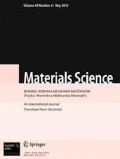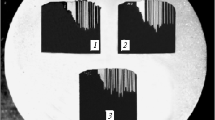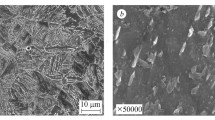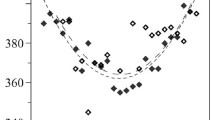By using the Ritchie–Knott–Rice criterion of local fracture, we analyze the conditions of initiation and propagation of microcracks in 13KhMF ferritic steel with various microstructures. The probability of fracture by transgranular cleavage for a given level of stresses σ yy in the tests for static crack resistance is estimated with regard for the grain sizes, the presence of carbides, and their dispersion. For steels with various microstructures, we determine the critical stresses σ C1.0 and critical lengths r C upon the attainment of which the material fails according to the mechanism of transgranular cleavage with probability P f =1.0.



Similar content being viewed by others
References
E. I. Krutasova, Reliability of the Metal of Power-Generating Equipment [in Russian], Énergoizdat, Moscow (1981).
A. Hernas and J. Dobrzański, Trwałość and Niszczenie Elementów Kotłów and Turbin Parowych, WPŚ, Gliwice (2003).
I. R. Dzioba, “Properties of 13KhMF steel after operation and degradation under the laboratory conditions,” Mater. Sci., 46, No. 3, 357–364 (2010).
T. Stakhiv, I. Dzioba, B. Lonyuk, and O. Student, “Structural degradation of heat-resistant steels and its influence on the parameters of crack resistance,” Fiz.-Khim. Mekh. Mater., Special Issue, No. 3, 67–72 (2002).
O. M. Romaniv, A. N. Tkach, I. R. Dzioba, V. M. Siminkovich, and A. A. Islamov, “Effect of long-term thermomechanical treatment on the crack resistance of 12Kh1MF steel,” Mater. Sci., 25, No. 2, 202–208 (1989).
O. M. Romaniv, H. M. Nykyforchyn, I. R. Dzioba, O. Z. Student, and B. P. Lonyuk, “Effect of in-service damage of 12Kh1MF steam-pipe steel on its crack-resistance characteristics,” Mater. Sci., 34, No. 1, 101–104 (1998).
I. Dzioba, “Wpływ długotrwałej eksploatacji na własności złączy spawanych rurociągów energetycznych,” Energetyka, XVIII, 39– 42 (2008).
I. Dzioba, “Wpływ składników mikrostruktury na własności mechaniczne i odporność na pękanie stali 13HMF,” Energetyka, XXI., 48–51 (2010).
A. Pineau, “Development of the local approach to fracture over the past 25 years: theory and applications,” Int. J. Fract., 138, Nos. 1–4, 139–166 (2006).
R. O. Ritchie, J. F. Knott, and J. R. Rice, “On the relationship between critical tensile stress and fracture toughness in mild steel,” J. Mech. Phys. Sol., 21, No. 6, 395–410 (1973).
R. M. McMeeking and D. M. Parks, “On criteria for J-dominance of crack tip fields in large-scale yielding,” in: ASTM STP 668, ASTM, Philadelphia (1979), pp. 175–194.
D. A. Curry and J. F. Knott, “Effect of microstructure on cleavage fracture stress in steel,” Metal Sci., 12, No. 11, 511–514 (1978).
A. Neimitz, M. Graba, and J. Galkiewicz, “An alternative formulation of the Ritchie–Knott–Rice local fracture criterion,” Eng. Fract. Mech., 74, No. 8, 1308–1322 (2007).
A. Neimitz, J. Galkiewicz, and I. Dzioba, “The ductile to cleavage transition in ferritic Cr–Mo–V steel: A detailed microscopic and numerical analysis,” Eng. Fract. Mech., 77, No. 13, 2504–2526 (2010).
I. Dzioba, M. Gajewski, and A. Neimitz, “Studies of fracture processes in Cr–Mo–V ferritic steel with various types of microstructure,” Int. J. Press. Vess. Pip., 87, 575–586 (2010).
A. Martin-Meizoso, I. Ocana-Arizcorreta, J. Gil-Sevillano, and M. Fuentes-Perez, “Modeling cleavage fracture of bainitic steels,” Acta Metalurg. Mater., 42, No. 6, 2057–2068 (1994).
A. Lambert-Perlade, A. Gourgues, J. Besson, et al. “Mechanisms and modeling of cleavage fracture in simulated heat-affect zone microstructures of a high-strength low-alloy steel,” Metal. Mater. Trans., 35A, No. 13, 1039–1053 (2004).
B. Tanguy, J. Besson, R. Piques, and A. Pineau, “Ductile to brittle transition of an A508 steel characterized by Charpy impact test, Part I: Experimental results,” Eng. Fract. Mech., 72, No. 1, 49–72 (2005).
A. Argon, J. Im, and R. Safoglu, “Cavity formation from inclusions in ductile fracture,” Metallurg. Transact., 6A, No. 4, 825–837 (1975).
S. Goods and L. Brown, “The nucleation of cavities by plastic deformation,” Acta Metal., 27, No. 1, 1–15 (1979).
F. M. Beremin, “Cavity formation from inclusions in ductile fracture,” Metal. Trans., 12A, No. 5, 723–731 (1981).
V. I. Vladimirov, Physical Nature of the Fracture of Metals [in Russian], Metallurgiya, Moscow (1984).
E. Smith and J. T. Barnby, “The nucleation and growth of cleavage microcracks in mild steel,” Metal. Sci. J., 1, 56–65 (1967).
J. J. Lewandowski and A. W. Thompson, “Micromechanisms of cleavage fracture in fully pearlitic microstructures,” Acta Metal., 35, No. 7, 1453–1462 (1987).
V. V. Panasyuk, Strength and Fracture of Solids with Cracks, FMI NASU, Lviv (2002).
H. K. D. H. Bhadeshia, Bainite in Steels, Institute of Materials, London (2001).
S. A. Firstov, T. G. Rogul, and O. A. Shut, “Hardening of polycrystals in passing from microscopic to nanostructured state,” Mater. Sci., 45, No. 6, 759–767 (2009).
R. E. Dolby and J. F. Knott, “Toughness of martensitic and martensitic-bainitic microstructures with particular reference to heat-affected zones,” J. Iron Steel Inst., 210, 857–865 (1972).
R. C. Thomson and H. K. D. H. Bhadeshia, “Changes in chemical composition of carbides in 2.25Cr–1.0Mo power plant steel. Part 1. Bainitic microstructure,” Mater. Sci. Technol., 10, No. 3, 193–203 (1994).
J. H. Tweed and J. F. Knott, “Micromechanisms of failure in C–Mn weld metal,” Acta Metal., 35, No. 7, 1401–1414 (1987).
Author information
Authors and Affiliations
Corresponding author
Additional information
Translated from Fizyko-Khimichna Mekhanika Materialiv, Vol.47, No.5, pp.82–89, September–October, 2011.
Rights and permissions
About this article
Cite this article
Dzioba, I.R. Influence of the components of microstructure on the static crack resistance of 13KHMF steel. Mater Sci 47, 662–669 (2012). https://doi.org/10.1007/s11003-012-9441-x
Received:
Published:
Issue Date:
DOI: https://doi.org/10.1007/s11003-012-9441-x




